Sushi
July 8, 2010
Near Portland (actually in Beaverton) there’s an awesome Asian supermarket called Uwajimaya. They have tons of Japanese pastries, different types of rice, implements for various types of Asian cooking, fresh fish of all types, and lots of other interesting stuff that I’d love to experiment with one day. Imagine a normal supermarket, but there are also sections with ten different types of things like nori.
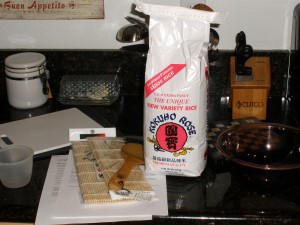 [caption id="attachment_752" align="alignleft" width="300" caption="The basic equipment."][/caption]
[caption id="attachment_752" align="alignleft" width="300" caption="The basic equipment."][/caption]
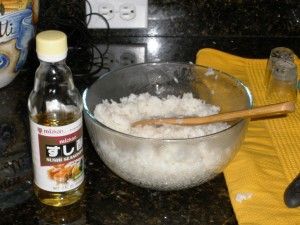 [caption id="attachment_753" align="alignleft" width="300" caption="Completed rice, and seasoning"][/caption]
[caption id="attachment_753" align="alignleft" width="300" caption="Completed rice, and seasoning"][/caption]
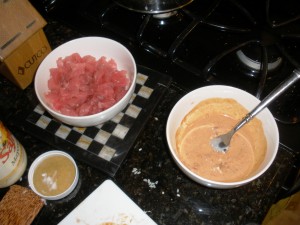 [caption id="attachment_754" align="alignleft" width="300" caption="Spicy tuna components."][/caption]
[caption id="attachment_754" align="alignleft" width="300" caption="Spicy tuna components."][/caption]
 [caption id="attachment_755" align="alignleft" width="300" caption="A completed spicy tuna roll. This one has too much rice!"][/caption]
[caption id="attachment_755" align="alignleft" width="300" caption="A completed spicy tuna roll. This one has too much rice!"][/caption]
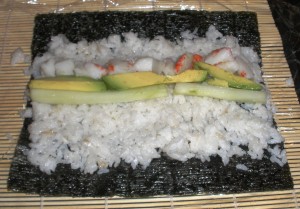 [caption id="attachment_756" align="alignleft" width="300" caption="Building a California roll."][/caption]
[caption id="attachment_756" align="alignleft" width="300" caption="Building a California roll."][/caption]
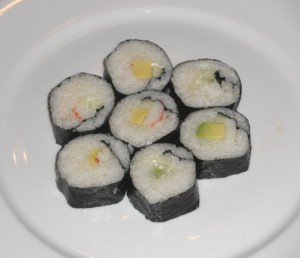 [caption id="attachment_757" align="alignleft" width="300" caption="A completed roll with coconut risotto filling."][/caption]
[caption id="attachment_757" align="alignleft" width="300" caption="A completed roll with coconut risotto filling."][/caption]
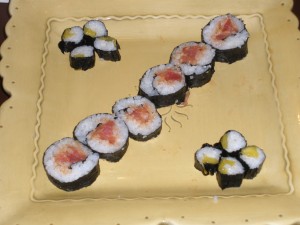 [caption id="attachment_758" align="alignleft" width="300" caption="Spicy tuna, and mango / coconut rolls."][/caption]
[caption id="attachment_758" align="alignleft" width="300" caption="Spicy tuna, and mango / coconut rolls."][/caption]
I stopped by there and bought all the basics:
Sushi rice. This is a special type of rice that dries with just the right amount of stickiness.
Nori. These are sheets of algae, which help to give structural integrity to rolls as well as a salty, savory flavor.
Rice wine vinegar. Added to the rice, together with a little sugar and salt, when it finishes cooking. (Though, as you may be able to see in the picture, I accidentally bought all this stuff premixed in a vinegar blend).
Bamboo sushi mats. These are mats made out of parallel bamboo sticks, with fastening strings running across them. They help to distribute the pressure of your hands when making a roll, so that the roll comes out more evenly.
The first step is simply to make the rice. This is fairly easy. Some rice wine vinegar and other seasoning is added as it cools, preferably in a wooden bowl that allows moisture to wick away, or at least in a non-metal bowl. (Metal bowls can react with the vinegar.)
Next, the roll is assembled. For a typical roll, a sheet of nori (commonly known as seaweed, actually algae) is placed on the bamboo mat, and covered with rice. The filling is put on top, and then the whole thing is rolled up.
I tried to squeeze the roll together as I rolled, if this makes sense. For example, if you have ever watched a burrito being made, you’ll notice the person rolling pull the stuffing toward them, and squeeze the burrito shut, as they roll. Same thing with an empanada - I learned to use a fork to keep the stuffing in place as I closed the pocket.
In general, doing this with stuffed foods keeps everything nice and tightly packed together, which is important for (a) structural integrity and (b) appearance. I have yet to develop any real skill in doing this, but I think I do understand the general principles now.
Three notes:
Nori is very fragile. When opening a packet of it, do not attempt to rip the plastic open. It is very likely that in so doing you will also rip all the nori sheets in half. Ask me how I know! Instead, just cut across the top of the packet with scissors, like a normal person.
Instructions generally indicate that you should place the nori “with the shiny side down”. This is not helpful, as both sides are quite shiny. However, one side is smooth, and the other is rough. Put the _smooth _side down, as that will face the eater.
To make an inside-out roll (where the rice is on the outside), you lay the rice down first, instead of the nori. But even before this, put a sheet of saran wrap down on the mat. This will keep the rice from sticking to it.
We made (a) California, (b) shrimp and avocado, © spicy tuna (with a special barbecue spice made of pureed chipotle peppers), and (d) mango rolls, with varying levels of success. I also made about half the rolls with coconut risotto substituting for the plain sushi rice. In many cases, this was quite delicious. It was a lot easier to build rolls with risotto, too, since it forms a solid, contiguous mass more easily. Having too much of it doesn’also t leave the roll flavorless. This is a promising approach that I look forward to using in the future.
Making a very thin layer of rice, and being conservative with the amount of filling, seem to be the keys to a tasty and well-built roll. The ingredients speak for themselves, so once you have selected and combined them, the quality of the roll construction is all you have control over.
I suppose you could say that about any cooking whatsoever. Once you have selected and combined the ingredients, all you have control over is the “construction” of the dish. But I guess what I mean is that there are many fewer variables in making a roll as opposed to, say, braising lamb, where you would have to consider e.g. cooking time, temperature, further seasoning, presentation, coordinating the completion of the dish with the completion of sides… perhaps this gaijin just doesn’t understand the subtleties!